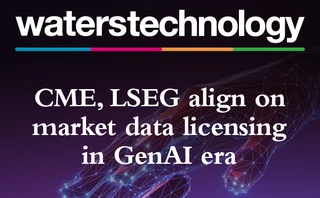Rob Daly: The Year of Exchange Alliances

Over the past year the global market structure has gone through major changes as consolidations and alliances among exchanges have made the potential access to liquidity in the coming year far easier for electronic and remote traders.
At the beginning of the year, exchange operators in Austria, the Czech Republic, Hungary and Slovenia came together to form the Central and Eastern Europe Stock Exchange Group (Ceeseg) holding company that provides the administration and management of the Budapest, Ljubljana, Prague and Vienna stock exchanges.
A few weeks after that announcement, four members of the Association of Southeast Asian Nations (Asean) also announced that they planned to launch the Asean Trading Link that would connect the Bursa Malaysia (BM), Philippine Stock Exchange (PSE), Singapore Exchange (SGX) and the Stock Exchange of Thailand (SET) via NYSE Euronext’s global Secure Financial Transaction Infrastructure (SFTI). The new linkage would electronically interconnect the participating Asean exchanges and allow their members to trade across borders and access multiple Asean markets from their home markets.
More recently, the stock exchanges of Chile, Columbia and Peru launched the trial phase of their integrated Mercados Integrados Latinoamericanos market that will trade stocks listed on all three South American exchanges and give the Argentinean and Mexican exchanges a run for their money, according to officials from the participating exchanges.
All of these alliances provide perfect arbitrage opportunities for each of the cross-listed securities and will likely draw the interest of electronic traders.
No one knows this better than the operators of the SGX, who plan to finalize their acquisition of the Australia Securities Exchange (ASX) sometime in the second half of 2011. The SGX has spent a good portion of this year deploying the necessary trading infrastructure to handle the volume and latency needed for electronic trading. It also implemented a number of agreements with larger trading venues, such as Nasdaq OMX and the London Metal Exchange (LME), to co-list American Depositary Receipts (ADRs) and certain metals contracts respectively. As a result, major electronic trading firms like Goldman Sachs and Getco have become members of the SGX.
Challenges
The key concern for these markets, even if they have the cross listing and the infrastructure in place, is whether they have enough liquidity to support electronic trading strategies. Firms thus far have not been able to drop trading strategies into new markets without a major amount of rewriting due to microstructure issues. However, broker-dealers’ trading algorithms tailored to thinly traded small- and mid-cap stock would work best in emerging markets.
The second issue that could determine the success or failure of these alliances is how well the foreign exchange (FX) markets serve them. With each of the new alliances that co-list issues, there is some sort of FX transaction needed to complete the trade. Except for Singapore, Australia and the euro members of Ceeseg, the remaining currencies are not members of the major FX currency trading pairs. This means to arbitrage the cross listing, it would typically take at least a two-legged FX trade to complete the equities trade.
This extra step will increase the cost of the trade on thinly traded stocks and the associated risk. If these alliances plan to grow and prosper, they will need the buy-in of the major FX banks to provide direct currency-pair trading to improve trading efficiency. Whether these banks find it more profitable to continue the two-legged trades or handle the new currency pair trading directly, only time will tell.
Only users who have a paid subscription or are part of a corporate subscription are able to print or copy content.
To access these options, along with all other subscription benefits, please contact info@waterstechnology.com or view our subscription options here: https://subscriptions.waterstechnology.com/subscribe
You are currently unable to print this content. Please contact info@waterstechnology.com to find out more.
You are currently unable to copy this content. Please contact info@waterstechnology.com to find out more.
Copyright Infopro Digital Limited. All rights reserved.
As outlined in our terms and conditions, https://www.infopro-digital.com/terms-and-conditions/subscriptions/ (point 2.4), printing is limited to a single copy.
If you would like to purchase additional rights please email info@waterstechnology.com
Copyright Infopro Digital Limited. All rights reserved.
You may share this content using our article tools. As outlined in our terms and conditions, https://www.infopro-digital.com/terms-and-conditions/subscriptions/ (clause 2.4), an Authorised User may only make one copy of the materials for their own personal use. You must also comply with the restrictions in clause 2.5.
If you would like to purchase additional rights please email info@waterstechnology.com
More on Trading Tech
WatersTechnology latest edition
Check out our latest edition, plus more than 13 years of our best content.
The total portfolio approach gains momentum: Building the right tech foundation for success
The rationale for the TPA, and the crucial role technology plays in enabling such an approach
Google, CME say they’ve proved cloud can support HFT—now what?
After demonstrating in September that ultra-low-latency trading can be facilitated in the cloud, the exchange and tech giant are hoping to see barriers to entry come down.
Institutional priorities in multi-asset investing
Private markets, broader exposures and the race for integration
BlackRock and AccessFintech partner, LSEG collabs with OpenAI, Apex launches Pisces service, and more
The Waters Cooler: CJC launches MDC service, Centreon secures Sixth Street investment, UK bond CT update, and more in this week’s news roundup.
TCB Data-Broadhead pairing highlights challenges of market data management
Waters Wrap: The vendors are hoping that blending TCB’s reporting infrastructure with Broadhead’s DLT-backed digital contract and auditing engine will be the cure for data rights management.
Robeco tests credit tool built in Bloomberg’s Python platform
This follows the asset manager’s participation in Bloomberg’s Code Crunch hackathon in Singapore, alongside other firms including LGT Investment Bank and university students.
FCA eyes equities tape, OpenAI and Capco team up, prediction markets gain steam, and more
The Waters Cooler: More tokenization, Ediphy lawsuit updates, Rimes teams up with Databricks, and more in this week’s news roundup.







